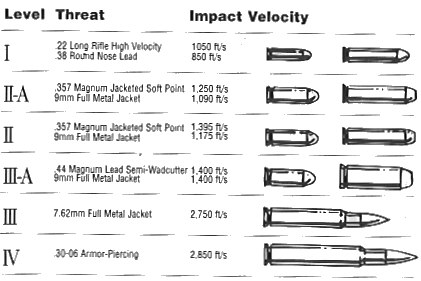
BODY ARMOUR
|
Myth and Misconceptions by A. W. Hellweg |
| Body armour is nothing new. Ancient
warriors have worn bronze, copper and iron breast plates as far as
recorded history. During World War II flack jackets were introduced and
by the Vietnam war nylon filled jackets were issued to troops.
Unfortunately, the jackets were very bulky and rather hot.
In the early 1960s DuPont was driven by two goals - to create a fibre with the heat resistance of asbestos and stiffness of glass. A breakthrough occurred in 1965 when Stephanie Kwoek, a research scientist at the DuPont Experimental Station in Wilmington, found that pare aminobenzoic acid could be polymerized and solubilized under special conditions to yield a rigid spinnable polymer. And so was the super fibre which we know as KEVLAR discovered. KEVLAR is now used world wide by manufacturers in the production of soft body armour and in many hard armour applications. Today we use a second generation KEVLAR. This is referred to as KEVLAR 129 and it is 15% stronger, 15% lighter and 20% thinner and softer than the original KEVLAR. This allows the manufacture of lighter weight personal body armour which is more wearable. There are other materials available that are used in soft body armour that are cheaper than KEVLAR, but incurring some trade off in regard to weight, comfort and/or bulk. To begin to understand how KEVLAR works, imagine several wooden sticks. With your fist you can break them one at a time. If they are tied together in a bundle, none can be broken. When KEVLAR is woven as a cloth and layered, a bullet encounters many threads at once. The denser the weave (the more threads per unit area) the more resistance the bullet encounters. Understanding this, we can understand some other properties of KEVLAR body armour. A small bullet fired at KEVLAR encounters fewer threads than a large bullet. A fast small bullet with the same total energy of a large slow bullet will penetrate body armour much deeper. A .357 magnum from a revolver is therefore easier to stop than a .22 magnum from a rifle. Additionally, the harder bullets do not deform on impact as much and penetrate more that softer bullets. A deformed bullet will encounter more KEVLAR and is more likely to be defeated. Stopping the bullet is only part of the problem. As KEVLAR does not stretch, when a bullet is contained, the energy is absorbed and dispersed from the struck fibres to other fibres in the weave of the fabric and ultimately to the body. This shock to the body is know as blunt trauma and must be kept at a level where injury from it does not occur. The human body can withstand a certain amount of blunt trauma and this tolerance to it is referred to in millimetres of "back face signature" during testing of body armour. There are numerous different test standards around the world. The oldest and best known standard is by the U.S. National Institute of Justice and know as N.l.J. 0101.03. This standard allows for a back face signature of 44mm when body armour is tested. This is regardless of level of protection the body armour offers. Other standards used, such as the U.S. PPAA Standard 1989-05 also use 44mm as the maximum allowable blunt trauma, but requires less shots fired against the armour being tested. Some armour that passes for instance the PPAA standard may still fail the NIJ standard during testing. As there is a lot of confusion about the various test standard, the harder NIJ standard is used by law enforcement agencies in the USA and generally in other countries which do not have their own test standards. In Australia, where there is no Australian standard, all body armour tendered for and also sold under contract by us to various Police and Government Departments MUST meet the NIJ standard. The NIJ standard is also required by all of our Asian and Middle East customers. In Europe we work manly to the German standard Schutzklasse "L" which allows only 40mm blunt trauma for concealment vests (Covert Armour) and 20mm blunt trauma for any type of vest which is worn over clothing (Overt Armour). In Finland where personal body armour is issued to every police officer the NIJ standard is used. In Great Britain we work to the Home Office requirement of 25mm blunt trauma using the NIJ test standard. This clearly demonstrates, that the NIJ Standard and its test method is most widely used standard in the world. There are basically six protection levels under the NIJ standard ranging from Level I for .38 revolver to Level IV for .30-06 Armour Piercing Rifle Ammunition and allows to test with any type of ammunition using the prescribed test methods. There are only five levels under the PPAA standard available, as this standard does not have a Level I for .38 revolver. The main level of protection used in Australia by Police Forces is Level III-A, as protection is required against the .22 magnum rifle. This round must not be confused with the .22 LR which is a much slower round and not metal jacketed. The .22 magnum is a widely used round in Australia and as it is a metal jacketed fast moving bullet, it is not easy to stop. However, with the new KEVLAR 129 type cloth stopping .22 magnum is not a problem and the armour is even lighter and more flexible than before. Level Il-Plus Covert Armour manufactured by us has the critical area of the front and rear of the vest reinforced to withstand any attack from .22 magnum and also from the more powerful .44 magnum. Also stopped are 9mm submachine guns in these areas, even though the armour is only referred to as a Level Il-Plus vest. There is a lot of myth and misinformation being spread on body armour in regard to test standards, weight, water resistance, UV light, perspiration and comfort. The weight of a vest will vary according to its protection level and to body area covered. When comparing weight of body armour of the same level of protection from different manufacturers, one must first establish the weight per square meter of the armour. This is the only way to compare weight of body armour, as the more body area that is protected, the weight of the garment will increase. The smaller the body armour panels, the lighter the weight. Also the finer the fibre, the lighter the fabric. Fibres are measured in deniers. A 750 denier fabric is much lighter and softer than a 1420 denier fabric, but also more expensive. Other factor that contributes to weight are the use of other materials than KEVLAR, such as Ballistic Nylons and other substitutes, which require more layers of fabric to achieve the same thread level. |
|
History |
| Wyatt Earp was most likely to be the first
Law Enforcement Officer to be saved by Body Armour. (Shoot-out at the OK
Corral. Shot by Billy Clanton and others from as close as 5 ft.).
1965 DuPont - Invented Kevlar |
|
Life Span of Body Armour |
| The National Institute of Justice (NIJ) suggests replacement after five years. Frequently worn concealable Soft Body Armour has failed to pass testing after 5 years of service. In general there is no degradation to ballistic fabrics if stored for prolonged periods, as long as they are stored correctly. |
| A 'bulletproof' vest will protect you from
the vast majority of pistol ballistic threats you are ever likely to
face. But there is always a tradeoff between more protection and more
wearability (and the constraint to stay within your budget). Please know
that:
rifle rounds, unusual high velocity pistol ammunition, pistol ammo fired from a rifle barrel, armor piercing ammunition, sharp-edged or pointed instruments (e.g., knives, icepicks, etc.), and other unusual ammunition or situations... CAN defeat body armor. For example, at some angles projectiles can slide, or deflect off the edges of Body Armor, or ricochet. Furthermore, projectiles that are successfully stopped by the vest will always produce some level of injury, resulting in severe bruising, broken bones, and possibly serious internal injury or even death. Body armor vests defeat most pistol and shotgun projectiles, but NO vest on earth makes you invulnerable. To state the obvious, getting shot ALWAYS carries some risk. |

The above picture shows how effective each type of bullet is against each armour

The trauma damage a bullet does
|
Level I: Early armour Not recommended. Early generation ballistic fibers, though bulkier, only stop fragmentation and low velocity pistol ammunition. Sometimes PASGT army surplus flak jackets are passed off as “about Level II-A”, but in our tests 9 mm penetrated. Excellent birdshot protection, riot gear or paintball equipment, but not recommended for pistol ballistic protection. (Level I protection is now considered to be inadequate for today's threats and not made any longer by most body armour manufactures). |
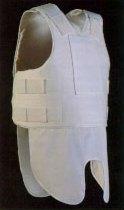
|
Level IIA: Covert armour The minimum recommended protection. Designed to defeat bullets discharged from short barrelled pistols and revolvers, typically 2-4 inches in length. Handguns with short barrels are known to be preferred by potential assailants in view of being readily concealed by clothing. This is the most comfortable vest type to be worn for sustained periods. For the vast majority of threats encountered on the street, though you would sustain more blunt trauma injury than Level II or III-A. The thinnest and best for concealability and comfort. $250 |
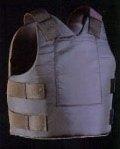
|
Level II : Standard protection Probably the most popular specification in the world. It is standard issue to police officers in the United States where gun crime overshadows that of Great Britain. This vest or jacket will defeat all but the most penetrative handgun rounds. A lightweight with heavyweight characteristics. $ 380 |
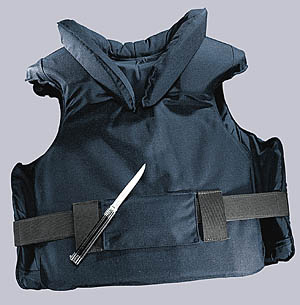
|
Level IIIA: Stab resistant With prison system populations on the rise, the likelihood of inmates injuring correctional officers with sharp and pointed objects is becoming an increasing threat. Realizing this threat several companies have designed a combination stab and ballistic vest. This Level III-A vest protects from sharp objects with force up to 81.2 ft-lbs. Minimizes blunt trauma injury from 9mm FMJ to allow more effective return fire. $450 |
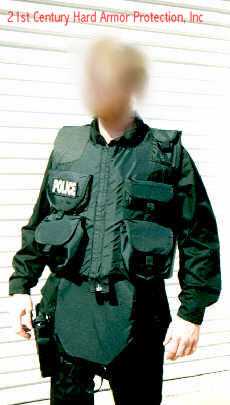
|
Level III: Tactical armour This armour was originally introduced to defeat the menacing power of the 44 Magnum Revolver. This weapon is generally too difficult to control without formal training, it is also a large gun that cannot be easily concealed. A 44 Magnum bullet will normally penetrate lower specification body armour, but this armour provides maximum protection against high velocity rounds from handguns and 9mm submachine gun. It is also tested to stop 6 rounds of .308 Winchester FMJ (Full Metal Jacket) (NATO 7.62 X 51 mm), and lesser threats, such as AK-47 / Kalashnikov 7.62 X 39 mm FMJ |
All of the vests above cover the chest and abdomen only, however the same materials can be used to fashion protective covers for both the arms and legs.
|
Ceramic Plates A ceramic armour system is a composite consisting of a ballistic nylon spall cover, ceramic tile, and a Kevlar™ or other reinforced plastic backing material. On impact, the ceramic fractures the projectile core. A major portion of the kinetic energy is absorbed by the ceramic, with residual energy being absorbed by the backing. Selection of the backing material is determined by structural, ballistic, and weight requirements. Various compositions of Kevlar, fiberglass, Spectra® and aluminium have all been used. |
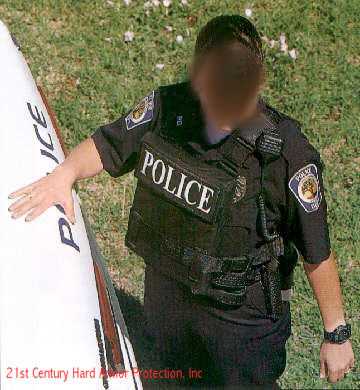
|
Level-III plates This insert weighs approximately 5.4 lbs. and is NIJ certified as stand alone against 7.62 FMJ 158gr. M-80 Ball round (308 Win.) with minimum velocity of 2750 fps. For a fast upgrade, an optional carrier can be thrown over your vest. Or, if tactical vest has 10" x 12" pockets, then these inserts should fit inside the existing pockets. $250 per Plate |
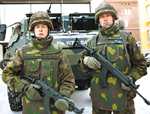
|
Level-IV plates Level IV inserts are designed to protect from 30-06 armour piercing rounds and all lesser threats. Made of ceramic with a Kevlar spall backing. The plates are usually rectangular sized at : 10" x 12". $280 per Plate |
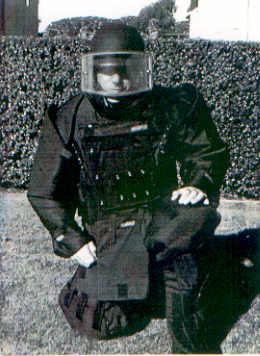
|
Blast protection Armour |
|
This suit has been designed to be light weight, extremely flexible and modular. It is suitable for a wide range of missions from tactical entries to bomb disposal. Designed for protection of personnel in operations involving the handling of Unexploded Explosive Ordnance (UXC) and Improvised Explosive Devices (IED). Mil-spec protection from high velocity fragments associated with the handling of explosive ordnance and devices. Constructed of Aramid ballistic inner fabric, and Nomex fire retardant outer fabric which, when worn properly, will provide fragmentation protection to the wearer. The system consists of: Coat with sleeves, Removable Collar and Groin Protector, Trousers (Front only), Spats (over feet), Helmet (Aramid fragment resistant), Face Shield (polycarbonate fragment resistant), Chest Plate (Aramid composite)SDC 280 AR 17 |
|
$6,000
|
|
Bomb Blankets |
||||
|
BOMB BLANKETS are effective against most pipe bombs,
hand grenade fragments and most fragmentation caused by pressure or
electrical explosion. A combination of layers of ballistic fabric sewn
together in a pattern to produce maximum strength then sewn into a
flame, acid and water-repellent cover.
SDC 380 |
||||
|
Barrier Blankets |
||||
| BARRIER BLANKETS are bullet-resistant units available in ballistic protection Levels II-A, II or III-A. Produced from multiple layers of Aramid fabric conforming to the protection level required, then sewn into a water repellent nylon cover. All blankets are available in the following sizes, plus Custom sizes and configurations available on request. SDC 480 | ||||
| Bomb Blanket | Barrier IIA | Barrier II | Barrier IIIA | |
| (122 cm X 122 cm) | $770 | $770 | $1,010 | $1,170 |
| (122 cm X 152 cm) | $945 | $945 | $1,235 | $1430 |
| (122 cm X 183 cm) | $1,040 | $1,040 | $1,495 | $1,755 |
| (152 cm X 183 cm) | $1,170 | $1,170 | $1,625 | $1,885 |
| (183 cm X 183 cm) | $1,430 | $1,430 | $1,950 | $2,275 |
| SDC | 380 | 430 | 480 | 530 |
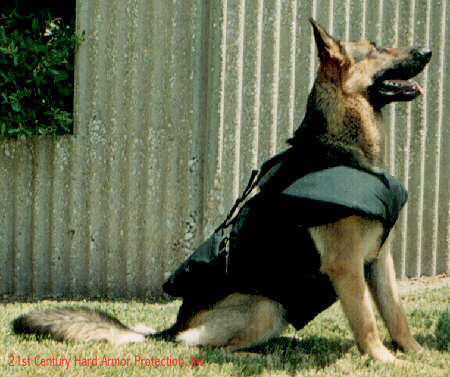
|
K-9 armour |
|
Many departments have Canine units in service and have found a need to protect the dogs with bullet proof barding . The K-9 vest was designed for police departments, but could be used by any organization. The K-9 vests are made of 1000 denier Cordura and the ballistic panels are removable for easy cleaning . The Cordura resists snagging and is durable against brush which helps protect the dog while in chase or search. Adjustable side elastic straps secured with Velcro to allow one size to fit police dogs 25 to 45 kg. (Measure your dog along the spine, base of neck to base of tail, if you are unsure of your dog fitting the standard size.). Level II-A; SDC 180, AR 15 Level II; SDC 200, AR 15 Level III-A; SDC 250, AR 15 |
|
Level II-A $600, Level II $650, Level III-A $700 |
|
Riot Armour |
| Standard issue police armour
SDC 180 AR 14 |
|
Price: $1600 |
| Concealable Body Armour |
| Entered service in the late 1990's. As the
name suggests a form of armour that can worn under clothing for low
profile missions. The additional front plate covers the heart, the rear
plate the spine.
Weight: (Vest only) 2.7 kg, (front plate) 1.4 kg, (rear plate) 1.8 kg. Vest plus two plates: 5.9 kg SDC: Vest only 300, with ceramic plates 600 AR: 17 |
|
Price: $1700 vest and plates |
|
Ranger Body Armour |
| Entered service in the early 1990's in the
75th Ranger Regiment. Used operationally in Somali, 1993. Consists of a
woodland camouflage kevlar vest with the same protection as the PASGT
vest (US version of the T2K Kevlar Vest page 62 v2.2 rulebook). A
ceramic insert provides protection against 7.62 x 39mm at 100 metres.
3-4 30 round magazines may be secured to the front by means of the
velcro straps.
Weight: (Vest only) 3.5 kg, (with ceramic plate) 7.3 kg SDC: Vest only 320, with ceramic plate 620 AR: 17 |
|
Price: $2738 vest and plate |
|
Interim Small Arms Protective Overvest |
| Entered service in the late 1990's for use
in Bosnia. Consists of an overvest carrier and two ceramic plates. Worn
over the PASGT vest. Only 4000 available in the US Army, mainly for
Military Police in peacekeeping operations.
Weight: 7.5 kg, plus 4 kg PASGT vest. 11.5 kg total. SDC: 600 AR:17 |
|
Price: $2330 |
|
Interceptor Body Armour |
| Interceptor replaces ISAPO. Consists of
Boron Carbide ceramic plates and a vest with protection against 7.62mm
rounds. They will be replaced by light weight, higher performance plates
as they become available (see MBA below). It can be worn as the kevlar
vest, with or without the front and back plates. Additional neck and
groin armour can be added. MOLLE webbing can be added the front of the
vest. This is the intended body armour for 1st generation
Land Warrior.
Weight: 3.8 kg (vest only), 1.8 kg (each ceramic plate), 5.6 kg (vest with 1 plate), 7.4 kg (vest with two plates) SDC: Vest only 350, with ceramic plate 650 AR: 17 |
|
Price: $2500 vest, $500 each plate |
|
SPEAR Body Armour |
| Special Forces Equipment Advanced
Requirement (SPEAR), the early 21st century body
armour for special forces troops. This armour might be proof against
7.62mm NATO AP rounds.
Weight: 2.9 kg (vest only), 2.7 kg (each ceramic plate), 5.6 kg (vest with 1 plate), 8.3 kg (vest with two plates) SDC: Vest only 650, with ceramic plate 950 AR: 17 |
|
Price: $3500 + $500 per plate |
|
AIRSAVE/SARVIP Body Armour |
| Aircrew Integrated Recovery Survival Vest
and Equipment (AIRSAVE) provides a vest with equipment pouches, Kevlar
vest and the option of hard armour plates proof against 0.30 AP rounds.
The plates are easier to remove if the crew member has to escape from a
aircraft that has ditched in water. A SARVIP (Survival Armor Recovery
Vest Insert and Packets) front insert can replace the hard armour plate,
this protects against 12.7mm AP rounds!
Weight: 2.6 kg (survival vest only), 2.9 kg (kevlar vest only), 2.9 kg (per 1 plate) SDC: Vest only 370, with AIRSAVE plate 670, with SARVIP plate 970 AR: 17 |
|
Price: $1160 survival vest, $1660 kevlar vest, $170 front plate, $180 back plate, $1010 SARVIP |
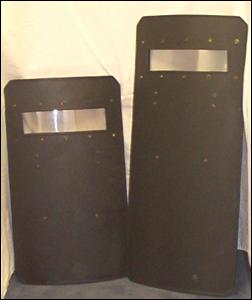
|
Ballistic Shields |
| Level III-A protection, including
the viewport, Extra-Large 4"x16" Viewport for better field of
view, Specially curved shape for greater rigidity and better coverage, Unique handle design, plus a neck retention strap, allows for comfortable ambidextrous use, and optimum mobility. Medium shield handle can also be utilized as a quick step ladder when shield leaned on wall.. SDC 430, AR 16 |
|
$1,370 |